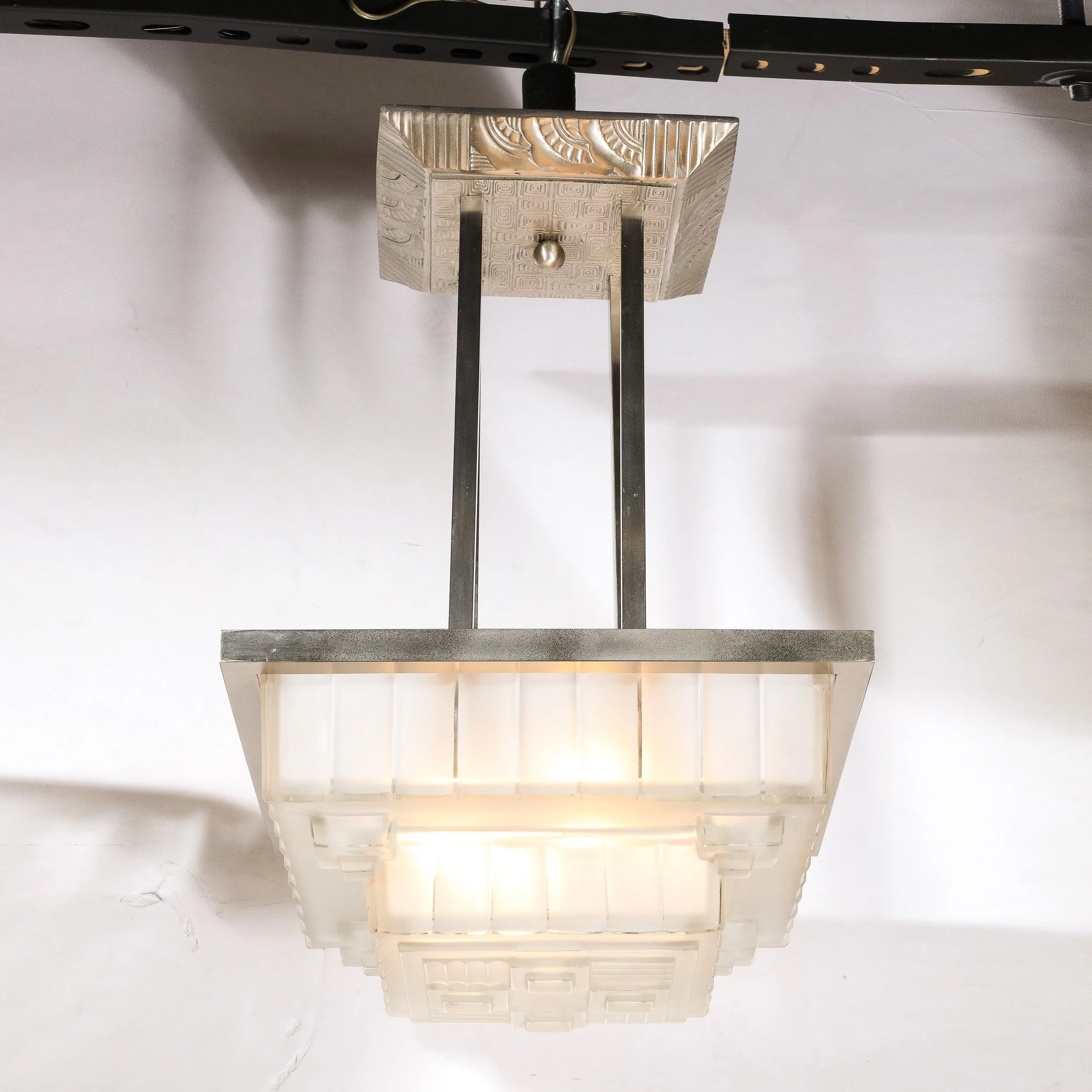Art Deco Chandelier in Skyscraper Frosted Glass & Silvered Bronze Signed Sabino

















Art Deco Chandelier in Skyscraper Frosted Glass & Silvered Bronze Signed Sabino
This stunning and important Art Deco chandelier was realized and signed by Sabino in France, circa 1935. Combining the opulent decoration of high style Art Deco with the economy of form of the Machine Age, this piece represents not only a striking but an important piece of 20th century design history. It features a frosted glass shade consisting of three stacked skyscraper style cubic forms. The sides are imprinted with rectangular patterns in relief, while the bottom of the shade has cubic decorations also in heightened relief. Stacked plinth forms protruding into the three dimensions sit at each corner of the lower tier. The shade connects to a silvered bronze base via four rectangular rods (in the same material). The base offers a wealth of classic Deco motifs including fan and streamlined forms, concentric square forms, and striations. With its iconically Art Deco sensibility (and materials) by one of the great makers of the period, this piece is sure to delight discerning collectors of 1930s design as well as those with a penchant for all things exquisite. It has been newly rewired to American standards. The chandelier accommodates four Edison based bulbs offering up to 400 watts of light. Signed Sabino.The height can be adjusted to suit.
France, circa 1935.
Dimensions:
Height: 28.5 in (72.39 cm) x Width: 19 in (48.26 cm) x Depth: 19 in (48.26 cm)
Glass Height: 9"
Creator: Marius-Ernest Sabino (Designer)
Power Source: Hardwired
Style: Art Deco (Of the Period)
Materials and Techniques: Bronze, Glass
Place of Origin: France
Period: 1930-1939
Date of Manufacture: circa 1935
Condition: Excellent, Rewired.
Reference Number: LU793433428562
MARIUS-ERNEST SABINO
During the 1920s and 1930s, the world of glass artisans was rich with talent, featuring renowned names like René Lalique, Etling, Hunebelle, D'Avesn, Verlys, and Jobling. Among these, Marius-Ernest Sabino emerged as one of the most prolific and influential figures, particularly known for his expertise in lighting.
Marius-Ernest Sabino, born on September 9, 1878, in Acireale, Sicily, moved to France at the age of four. In Paris, he studied woodcarving, following his father's footsteps, and later attended L'Ecole Nationale des Arts Decoratifs et de Beaux Arts (the National School of Decorative and Fine Arts). Sabino's fascination with the burgeoning technology of electricity led him to replace his initial wooden chandelier models with innovative glass designs that effectively diffused light.
After World War I, Sabino collaborated with a glazier in Romilly-sur-Andelle before establishing his own factory in Noisy-le-Sec, along with large stores in the Marais district of Paris. His expertise in glass relief sculpture garnered significant attention, particularly at the International Exhibition of Decorative Arts in Paris in 1925, a year that marked the peak of his creative output. Sabino's chandeliers gained immense popularity, aligning perfectly with the light-themed architecture of the era.
Sabino's reputation for creating exquisite decorative lighting led to prestigious commissions, including designing lighting for ocean liners such as the S.S. Ile de France in 1927 and the S.S. Normandie in 1935. His fame continued to grow, and by 1935, he was commissioned to produce all the electric light fittings and chandeliers for the palace of the Shah of Persia. His business expanded internationally, with outlets in Algiers, Oran, Tunis, and Constantinople.
Sabino's lighting creations were notable for their use of crystal iridescent blue, also known as "golden glass" in Britain. He achieved this unique opalescence by adding arsenic, which later extended to shades of purple and yellow. His chandeliers and other lighting pieces were celebrated for their meticulous craftsmanship, combining innovative techniques with luxurious aesthetics.
A typical day for Sabino involved instructing his draftsman and sculptor, while the cast glass production was subcontracted. Quality control was stringent at his Noisy-le-Sec plant, ensuring that each piece met his high standards. Variations in the appearance of his signature on different pieces are attributed to the different workers responsible for this task.
The models that achieved the greatest success were those created before 1939, as the German occupation during World War II led to the closure of Sabino's glass plants. During this period, some pieces were cast in metal alloy. After the war, due to illness, Sabino retired, and his artistic and commercial directors continued his work. Although his molds were no longer used, production of his designs continued until 1975, well after his death in 1961 at the age of 83. Pieces bearing his name continued to be made after this period, as his molds were sold to an American company that continues to manufacture in France.
Marius-Ernest Sabino's legacy as a master of Art Deco lighting endures. His innovative use of glass and light, combined with his dedication to craftsmanship, has left an indelible mark on the world of decorative arts. Sabino's creations remain highly sought after by collectors and continue to inspire contemporary designers.


